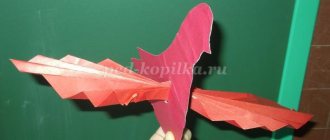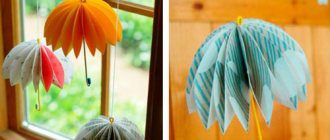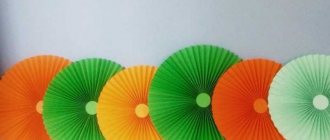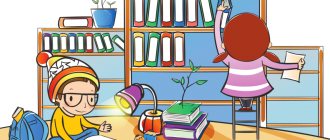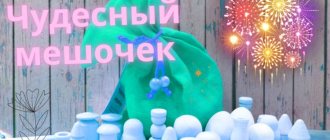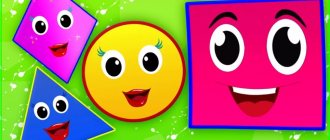Notes on manual labor in the preparatory group. Doll made of threads
Notes on manual labor in the preparatory group.
Abstract. Author: Olga Vasilievna Mikhailovskaya, teacher Place of work: MKDOU No. 3, Barabinsk, Novosibirsk region
Summary of the educational instruction on manual labor in the preparatory group “Thread Doll”
Goal: expanding knowledge and skills in the field of arts and crafts Objectives: - continue to introduce children to Russian folk crafts and Russian traditions;
- introduce children to a folk craft - making dolls from threads; — teach techniques for making dolls from fibrous materials in accordance with folk traditions; - develop fine motor skills of the hands; - arouse interest and cultivate a love for Russian folk art and handicrafts; — to form children’s aesthetic taste, develop imagination, and the ability to fantasize. Materials: sample of a finished doll, illustrations of folk dolls, balls of woolen thread, boxes for winding threads when making blanks for the body and arms, scissors. GCD move:
Educator: - Guys, today I want to tell you one very interesting story. In ancient times, when children did not have toys like yours, craftsmen and wizards made toys with their own hands. The children's favorite toy was a doll, and it was a little different than the dolls you play with now. A doll is not born on its own: it is created by a person. Being a part of culture, the doll retains in its image the features of the people who created it. Dolls were made according to certain rules. There was a belief that when making ritual dolls it was forbidden to use piercing or cutting objects that could injure a person. Therefore, the fabric and threads for the dolls only had to be torn by hand. And another indispensable condition for making a doll was its facelessness. The doll had no... face. Since she played the role of a talisman, they were afraid to completely liken her to a person. According to popular beliefs, a doll “with a face” seemed to acquire a soul and thereby become dangerous for the child. It was believed that she could jinx the child and bring misfortune. Such dolls were made until the 18th century. But this was not the only reason for her facelessness. Playing with such a faceless doll encouraged the child to imagine, fantasize, invent its mood and character, and imagine it in different play situations. “You and I will become craftsmen from an ancient Russian village and we will make a doll from threads.” This work is not so simple, so we will help each other. We will make dolls from threads, but using the same techniques as the ancient masters. Please note: the colored thread for tying the bunches will also be a decoration. It depicts a necklace, belt and cuffs, which also had a protective meaning in the clothing of ancient people; The master did not make any other decorations. Materials and tools that we will need next: In front of each of you on the table are: yarn (colored threads), auxiliary cardboard or small books, scissors. Safety briefing Before starting work, we will follow the safety rules. Today we will use scissors very little, but still. Don’t joke with scissors, don’t twist them in your hands in vain And, holding them by the sharp edge, pass them on to a friend. As soon as the work is finished, the scissors need care: Don’t forget to close them and put them back in place. To begin with, I suggest you stretch your hands and fingers to make it easier for you to work. Finger gymnastics “Shadow shadow sweat.” Shadow, shadow, shadow, (hits with both hands on the knees in turn and 2 claps) There is a wattle fence in the garden (palms with outstretched fingers are crossed) In the hut the stove is lit (show the roof with two palms, and then connect the thumbs of both hands, depicting fire ) Grandma is in a hurry (depicting with her index and middle fingers how grandma is walking) She bakes turnips (depicting how pies are made) Places them on plates (alternately hit the right and then the left palm with your fingertips) Cat to the plate - hop! (make claws and clap once) I burned my nose! (cover your nose with your hands). Practical work - and now, I suggest you get to work. (All work takes place with musical accompaniment: Russian folk melodies sound). First stage: blanks for the torso and arms - winding threads on the box. Next, the blank is removed from the box, pulled together in the middle with a thread, and the head of the future doll is fixed. At the bottom, the threads are cut along the fold, the body is formed, and tied with thread.
— Now we drag the colored thread along the imaginary waist line of the doll. Then, the doll’s palms are tied with colored threads. The doll (boy) also has legs that are pulled over.
Today we made a doll based on folk images. In the old days, the doll was made from straw, since straw was an accessible and cheap material; the most ancient meaning of the doll is magical; later it was a toy for children; In modern life, the meaning of this product has partly changed; other materials are used.
We have created wonderful dolls that will bring you health, kindness, and a happy life. Result of the work: - What did you like about our lesson?
We recommend watching:
Summary of GCD in the preparatory group on the topic “Getting to know emotions” Summary of GCD in the preparatory group “Meeting with letters” Open lesson in the preparatory group on the topic: Waltz Do-it-yourself yarn doll. Master class with step-by-step photos
Similar articles:
Abstract of GCD in mathematics in the preparatory group. Count to 18
Summary of GCD in the preparatory group. Topic: Etiquette
Summary of GCD in the preparatory group on the topic: Kindergarten
Lesson notes for the preparatory group. Cultured man
Summary of a lesson on labor education in the preparatory group. Inventions and achievements of man
MAGAZINE Preschooler.RF
Demidova Nina Vasilievna Teacher of Children's School No. 37 "Golden Key" Yelets, Lipetsk region,Program content: Expand children's knowledge and understanding of the features of the appearance of butterflies. Continue to develop skills in working with natural materials. Learn to plan your work (when making crafts, analyze and compare individual operations, highlight the method of action, the sequence of their implementation). To form a desire for aesthetic transformation of the environment, aesthetic taste and work culture. Develop fine motor skills of the hands. Materials for the lesson: floral sponge (blanks cut out by the teacher in the shape of a butterfly’s body); bay leaf leaves; seeds of corn, pumpkin, watermelon, sunflower; self-adhesive in different colors; scissors.
Progress of the lesson: Teacher. Guys, I want to tell you an interesting fairy tale called “Magic Transformation.” (The teacher puts a beautifully packaged box on the table, shows and tells a fairy tale). Teacher. In this magic box lives a fairy tale about a caterpillar who lived in an apple tree in the garden and loved to eat leaves. The caterpillar lived well and freely on the tree, there was a lot of food, the sun was warm, and if it was cold and it was raining, the caterpillar wrapped itself in leaves, warmed up and fell asleep until the morning. And in the morning she got down to business again, ate, crunched juicy leaves, basked in the sun and enjoyed life. But then autumn came, the leaves on the apple tree became dry and yellow, and the winds and cold were so strong that a blanket of leaves no longer saved our caterpillar. And so, waking up in the morning, cold and wet, she decided to build a house, and, of course, only from the threads that she makes herself. Without delaying the work, she began building her house. She worked for a long time, neither slept nor ate for three days and three nights, and the house turned out just fine, round, soft, warm, but this house had no windows or doors. And our caterpillar became so warm and cozy that she fell asleep and slept through the entire cold winter and early spring, and woke up only when the apple tree blossomed. The caterpillar reached out, for some reason she felt very cramped in her house, the cocoon cracked and she found herself on the street. But what happened, it’s not our glutton caterpillar and graceful beauty butterfly. The butterfly really wanted to eat, but she did not and could not eat the leaves, she wanted something very tasty and sweet. She fluttered up and flew to the most beautiful flower, then to another, then to a third. Having eaten, she sat down on a flower and became sad, and only the breeze gently rocked the beauty in the wind. Teacher. - Guys, why did the beautiful butterfly suddenly feel sad? Children. - (Answers). Teacher. - That's right guys, a butterfly has no friends! - Guys, can we help the burning butterfly? Children. (Answers). Teacher. - But as? Children. Let's make the same beautiful butterflies. Teacher. - But first, I suggest you consider the diagram. Children. (They examine, ask questions). The teacher explains. Before starting work, he suggests doing a short warm-up. Physical education break. The flower was sleeping, and suddenly woke up, not wanting to sleep anymore. Started up, stretched, soared up and flew. Close your eyes, relax, blink your eyes. Raise your hands up (inhale) Look at your hands. Arms bent to the sides (exhale) Shake your hands, look left and right.
Practical part. Teacher. Today we will make a butterfly from natural material. The body of the butterfly will be made of floral sponge, and the wings will be made of laurel leaves, we will attach them to the body, but first you need to decorate the wings. To do this, you need to take colored self-adhesive paper and cut out a pattern for the wings from it. It must be remembered that the pattern on the wings of a butterfly is symmetrical, that is, one wing is exactly reflected in the other, like in a mirror. Therefore, when gluing color patterns on one wing, it is necessary to simultaneously make the same patterns on the other in the same color, size and location. Decorate the body with seeds, make eyes and antennae. While working, we remind children that the floral sponge is a very soft and fragile material, and you need to be very careful when working with it.
Final part. Teacher. He invites the children to “let their butterfly fly” and notes that our group has turned into a green meadow, over which motley-winged beauties—butterflies—flutter merrily, and not one of them is the same. Reads a poem by A. Sobrasov Butterfly, let's be friends! It's more fun to live in friendship! We have flowers in the garden, fly over them. No rain over the garden. No need to worry in vain. Don’t worry about anything. Hide under my Panama hat!
| Next > |
